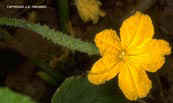|
|
|
The family Cucurbitaceae lies within the class of dicotyledonae and in the division of anthophytha. There are about 100 known genera and almost 700 species in this family. It is know to many as the gourd or pumpkin family. |
 |
They usually produce spiraling tendrils or modified shoots that wrap around adjacent objects and use them for support. This is why they are considered vine crops. Cucurbits usually are climbing plants with alternate, simple, palmately veined leaves. The plants are usually monoecious with both pollen bearing male flowers and seed bearing female flowers on the same plant. There are, however, some dioecious species. |
|
|

The female flowers consist of 3 stigma lobes with an inferior ovary. |
Pollination must be performed by outside carriers such as honeybees because the pollen is not wind borne. Curcurbits usually produce what is called a pepo, or a berry that has a thick leathery rind. |
 |
There are also species such as wild cucumber, Echinocystis lobata, that produce a seed bearing capsule that splits open when ripe to release its seeds. These plants can wreak havoc in corn and bean fields. They can make it nearly impossible to harvest a field infested with this weed. |
|
|
|
|
There are many species of Cucurbitaceae that are important economically. Some are used just for decoration. Most are grown commercially for their nutritive value. Cucumbers, Cucurbita sativus, are grown for fresh market use, and also for pickling. They are produced from California to North Carolina. Pickling cucumbers are a major part of the income for these migrant farm workers in Sandusky county, Ohio. These are picked every third day and taken to the Heinz company in Fremont, Ohio. A typical growing season is about six weeks. Pumpkins, Curcurbita pepo, are also grown all over the country including Ohio. They are grown mostly for decoration around Halloween time. Some are grown for use in pumpkin pies and also for their seeds. This is a field in Sandusky county during pollination. When harvested these pumpkins will be sent as far as Long Island, New York. |
|
|
|
|
Watermelon, Citrullus lanatus, is another commonly grown plant of Ohio. It is usually germinated in a greenhouse and transplanted when temperatures become warm enough. This is usually about May. Sheets of plastic are laid down to keep moisture in the ground and to the weeds down. In Ohio watermelons are typically harvested in August. |
 |
There are modern varieties of watermelons that produce no seeds. They are derived from 4n parent being combined with 2n parent to produce a 3n offspring. These plants are sterile but when pollinated with a 2n plant they will produce seedless watermelons. The seedless variety is planted in the same field as the conventional variety. |
|
|
|
Cantaloupe, Cucumis melo, is another important member of the Cucurbitaceae family. It grows in a similar way to the watermelon. but cantaloupes require less time to reach maturity. |